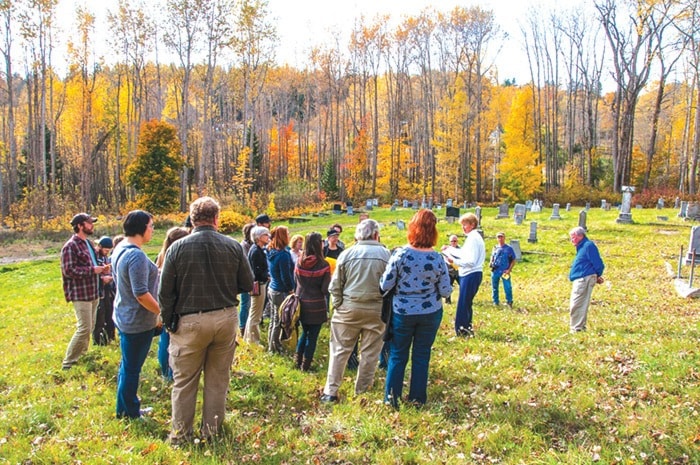“The cemetery reminds me of the history of Rossland,” says Jackie Drysdale, chairperson of the Rossland Heritage Commission during her tour of Rossland’s Columbia Cemetery.
On Sunday, October 19, a rather large group met at the top of Rossland’s Mountain View Cemetery to go on an hour-long tour with Drysdale in the old cemetery in Happy Valley. “What a wonderful turnout,” announced a smiling Drysdale.
The Rossland Museum and Discovery Centre sponsored the tour and Drysdale shared her knowledge together with help from expert Pat Goulden of Salmo.
There were participants from every age group in the tour and everyone was curious to learn about Rossland’s history. Drysdale showed the group around the different areas of the old cemetery and talked as she went.
“Columbia Cemetery is one of Rossland’s most important historic sites because it embodies so much history of Rossland and Rosslanders in ways that other sites and buildings can’t,” explained Drysdale.
She also shared what work has been done by the city to preserve the site. Brush has been removed, and tombstones and monuments have been cleaned and restored.
The Heritage Commission is currently looking for volunteers that would like to do simple work like clearing off lichen. Recently many gravesites have been found to be covered in brush. Several monuments have fallen over as well.
Columbia Cemetery looks as good as it does today because of hard work and four years of research. However, though the burial permits have also been organized, many are missing or lacking information.
There are currently 110 people buried in the cemetery without there being any knowledge of their location. Back in the day they used wooden grave plaques and the people in charge once decided to clean up the cemetery with grassfires.
Of the few Chinese immigrants buried there, their burial permits are categorized in the books under “C.” Many bodies were shipped back to China, but the few buried here were subject to criticism of their culture; they placed offerings of food onto graves, and questioned the purpose of placing flowers.
Drysdale shared that in the early 1900s many died of fevers and diseases that are curable today. Frequently, cause of death was due to mining and railway accidents or stabbing.
The Heritage Commission works closely with Rossland Museum and Discovery Centre to uncover more facts of Rossland’s and the Rosslanders history. “The museum has the records. Together we tell the story,” says Drysdale.
